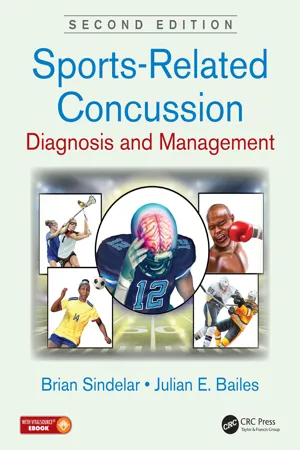
eBook - ePub
Sports-Related Concussion
Diagnosis and Management, Second Edition
This is a test
- 257 pages
- English
- ePUB (mobile friendly)
- Available on iOS & Android
eBook - ePub
Book details
Book preview
Table of contents
Citations
About This Book
This new edition reflects the explosion of knowledge in basic science and clinical care for athletes with mild traumatic brain injury or concussion. Interest in management and methodology for making diagnoses and improving the clinical outcomes have changed dramatically. All U.S. states have laws dictating how sports concussion patients are cared for and require return to play decisions be coordinated with best practice methods. Epidemiology, classification, and biology of sports concussion, as well as, brain imaging, assessment tests, neuropsychological measures, and management strategies are covered. Illustrative clinical cases, correlative examples, and historical insights are featured.
Frequently asked questions
At the moment all of our mobile-responsive ePub books are available to download via the app. Most of our PDFs are also available to download and we're working on making the final remaining ones downloadable now. Learn more here.
Both plans give you full access to the library and all of Perlego’s features. The only differences are the price and subscription period: With the annual plan you’ll save around 30% compared to 12 months on the monthly plan.
We are an online textbook subscription service, where you can get access to an entire online library for less than the price of a single book per month. With over 1 million books across 1000+ topics, we’ve got you covered! Learn more here.
Look out for the read-aloud symbol on your next book to see if you can listen to it. The read-aloud tool reads text aloud for you, highlighting the text as it is being read. You can pause it, speed it up and slow it down. Learn more here.
Yes, you can access Sports-Related Concussion by Brian Sindelar, Julian E. Bailes in PDF and/or ePUB format, as well as other popular books in Medicina & Neurocirugía. We have over one million books available in our catalogue for you to explore.
Information
1
Introduction to sports related concussion
Introduction
Prior to diving into the complex physiology, presentation, and treatment of concussion, an initial introduction of the historical definition is required followed by its evolution into its current designation. Though our knowledge of concussion has deepened through advanced neuroimaging and preclinical animal research, there still remains shortcomings regarding our understanding of this topic which has led to challenges in providing a stable definition. We will present these changes in the definition of concussion, and how this has influenced the ability to accurately provide a concussion incidence in sports. Lastly, we will review how the epidemiology of various sports-specific concussive injuries has influenced game-play alterations in order to make the sport safer for athletes.
“What’s in a name?”
Concussion or mild traumatic brain injury?
Concussion comes from the Latin word “concutere” which means to shake violently. In the 1300s, Lanfrancus became the first modern physician to define concussion as a transient alteration in cerebral functioning.1 Since that time, numerous terminologies have been used in order to describe this injury: “mild traumatic brain injury (mTBI),” “mild brain injury,” “mild head injury,” and “ding.”2 Even within the medical community, mTBI and concussion is used synonymously to denote a similar injury, which is actually erroneous.3
The Glasgow Coma Scale, GCS, was originally developed as a clinical classification scheme to rapidly describe traumatically injured patients by evaluating their alertness, mentation, and functional abilities. This crude but easily communicated system is determined by the following patient characteristics–eye opening, verbal response, and motor activity–with a total score ranging from 3 to 15 (Table 1.1). Scores between 13 and 15 denote a mild traumatic brain injury, or “mTBI.” After a concussion, athletes are typically alert, communicative, and following commands. Therefore, in the majority of concussed athletes, the GCS scale would assign this player as having a “mTBI.”
Table 1.1Glasgow Coma Scale
Eye Response | Verbal | Motor | ||||
|---|---|---|---|---|---|---|
1 | Does not open | Non verbal | No movement | |||
2 | Opens to painful stimuli | Incomprehensible | De... |
Table of contents
- Cover
- Half Title Page
- Title Page
- Copyright Page
- Contents
- Preface
- Chapter 1 Introduction to sports related concussion
- Chapter 2 Biomechanics and pathophysiology of concussion
- Chapter 3 Acute assessment, diagnosis, and management of the concussed athlete
- Chapter 4 Severe head injuries
- Chapter 5 Postconcussive syndrome
- Chapter 6 Outpatient care of the concussed athlete: Gauging recovery to tailor rehabilitative needs
- Chapter 7 Return to activity following concussion
- Chapter 8 Neuroimaging in concussion
- Chapter 9 The advent of subconcussion and chronic traumatic encephalopathy
- Chapter 10 Promising advances in concussion diagnosis and treatment
- Index